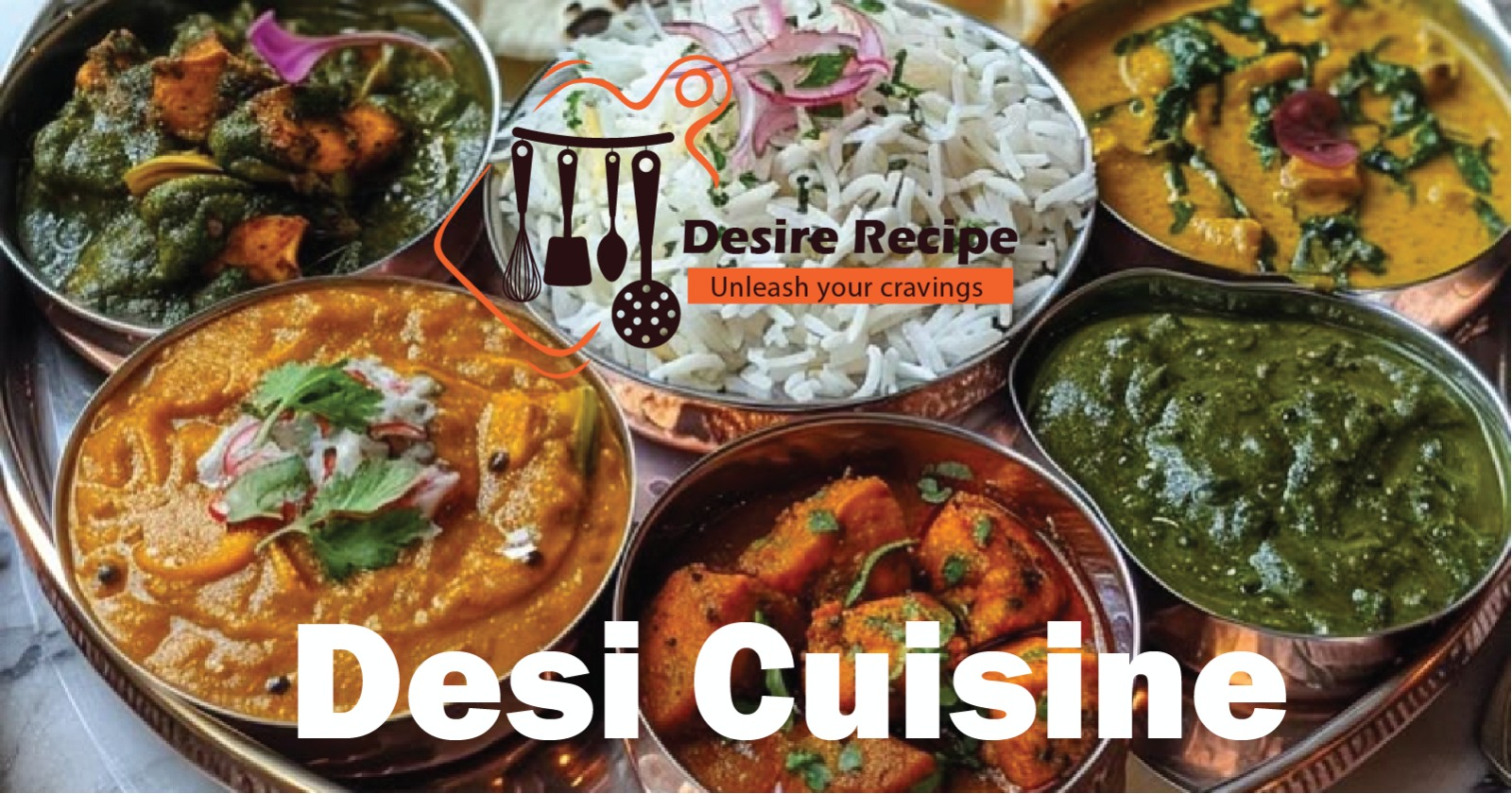Desi cuisine, which encompasses the diverse cooking culture of India, Pakistan, and Bangladesh, is a vibrant combination of flavors. The term “Desi” hints at the cultural melting pot that this classify represents, combining ancient ingredients, techniques, and regional differences.

At the heart of Desi cooking is a trick: an array of spices, each with its unique import and health benefits. From hearty vegetarian spreads to flavorful domestic dishes, Desi recipes cater to every palate. Whether you’re fasting Indian meals quickly or probing traditional Pakistani dishes, Desi cuisines offers a lovely culinary experience.
Section 2: Desi Recipes’ Historical Development
As the Years Passed, several civilizations and historical incidents have influenced the growth of Desi cuisine. Tomatoes and potatoes, which the Portuguese brought to India in the 16th century, were majority in many Indian recipes. By introducing fragrant spices and cooking methods, the Mughal dynasty significantly enhanced the culinary scene and produced delicacies like tandoori chicken. Similarly, the rich culinary traditions of the Mughal era are reflected in the development of Nihari as a filling breakfast dish. Together, these historical influences have molded the delicious and varied characteristics of contemporary Desi cuisine..
Section 3: Staple Ingredients in Desi Cooking
Desi cuisine depends on a variety of chief gredients that form the thesaurus of its rich flavors. Rice, ordinarily aromatic basmati, is a common for abundant dishes. Wheat is used to make unraised breads like roti and naan, which are indispensable to more meals. Legumes such as lentils are cooked into hearty dals, supply protein and texture. Ghee, a clarified butter, includes richness to both , palatable and sweet dishes. Spices like cumin, coriander, cardamom, and garam masala are bottom, crafting the tastes nature of Desi dishes.
Section4: Traditional Cooking Techniques
Desi food offers client a range of documentary cooking methods that increase the depth and richness of its tastes.
Tadka (Tempering) Whole spices are shortly fried in hot oil or ghee to enhance their tastes; this technique is usually client to enhance the flavor of dals, curries, and vegetables.
munchery
Dum (Slow Cooking): This method allows the components to cook in their own juices by cooking food in a sealed container over a low flame, hence developing the tastes. Reddit+ fourThe Ghee Spoon Blog, Pure Indian Foods+ fourWikipedia
Bhunao: Stir-Frying and Sautéing A combination of sautéing, stir-frying, and stewing, this method cooks components at medium to high heat while continuously stirring to avoid sticking, so creating a thick, spicy paste. Desi Fresh Foods +1The Ghee Spoon Blog+1, Pure Indian Foods
A North Indian method called dhumaar (smoking) involves putting a tiny bowl containing a piece of burning charcoal inside a bigger dish over the cooking meal. The whole item is covered with a lid to keep the smoke inside, therefore infusing the food with a smokey taste, by pouring a little ghee over the coal. The Ghee Spoon Blog, Pure Indian Foods

Using a tandoor (clay oven), Tandoori Cooking is a technique that roasts and bakes at high temperatures, hence giving a unique smokey flavor to meats and breads like naan. The Ghee Spoon Blog, Pure Indian Foods
Passed down through the years, these methods help to create the rich and varied gastronomic legacy of Desi food.
Section 5: Festive Foods and Their Significance
Festivals in Desi accomplishment, are celebrated with a rich item, of traditional dishes, each holding special meaning. During Diwali, the events of lights, families furnishsweets like ladoos and barfis, emblematize prosperity and joy. On Eid, biryani—a enjoyable taste mix of basmati rice, spices, and meat—is a festive component, representing correlation and tradition. Similarly, during Onam, the Kerala cutting festival, a grand meal called ‘sadya’ is served, envisaging a assortmen of vegetarian dishes on a banana leaf, reflecting doze and gratitude. These flexibility traditions not only relief the palate but also strengthen difference bonds and preserve cultural standards.
Section 6: Modern Twists on Classic Recipes
Desi cuisine beautifully components traditional flavors with modern creations,, resulting in dishes that disgraces heritage while charming to contemporary tastes. Chefs and home cooks alike are reexamining classic recipes to align with Wellness-oriented preferences and global palates.
Health-Conscious Adaptations: Traditional dishes are being infinite to enhance unhealthy value without negotiation flavor. For instance, quinoa biryani replaces undeveloped grains with protein-rich quinoa, submit a wholesome yanks on the beloved classic.
Latest news & breaking headlines
Fusion Creations: The art of division, Desi flavors with global cuisines has led to inspiring culinary innovations
Section 7: Culinary Tourism: Exploring Desi Food Trails
Sailing on culinary tours through South Asia offers an immersive experience into the region’s rich gastronomic custom. Each ejection presents a unique tapestry of flavors, principles, and culinary artistry.
Chandni Chowk, Delhi, India: This diligent market area is a food-lover’s heaven, offering plenty of street foods
Section 8: Sustainability in Desi Cooking
Desi cuisine is surrounding sustainability by returning to traditional urban and cooking methods. In Pakistan’s Pothohar Plateau, cultivation are empowering farmers to adopt irrational practices, moving away from chemical manure towards essential farming, which benefits both health and the environment.

Section 9: Interviews with Renowned Desi Chefs
Engaging with reputable Desi chefs offers invaluable sensitivity into the rich tapestry of South Asian cuisine. Chef Vikas Khanna, for perceptivity, reflects on his perception from Amritsar to earning Michelin stars, highlighting the global perception of Indian culinary arts. Similarly, Chef Atul Kochhar shares his outlook on modern Indian cuisine, minimizing a blend of tradition and innovation. These exchanges shed light on the growth, challenges, and global authorities of Desi cooking, refining our understanding and praise of its diverse flavors and methodologies.
Section 10: The Future of Desi Cuisine
Cuisine is growing, blending tradition with fashionable trends. In 2025, there’s a growing interest in regional Indian dishes, with chefs reviewing classics using hyper-local elements. Fusion cuisine is gaining favor, combining traditional flavors with global imports to create unique culinary skills. Acceptability is also a focus, with many opting for farm-to-table practices and eco-friendly dining options. Additionally, the rise of non-alcoholic facilities and innovative mocktails flaunts a shift toward mindful drinking. These evolutions highlight Desi cuisine’s dynamic nature and congratulate its rich heritage while isolating contemporary culinary innovations.
FAQs:
What is desi food?
- There’s a common assurances that Desi foods comprise largely of staple dishes like rice, dal, roti, and sabzi. nevertheless, Desi cuisine is incredibly diverse, with each region offering a variety of dishes, cyclic vegetables, and recipes that add options for vegetarians, non-vegetarians, and vegans.
Does Desi cuisine cater to different dietary needs?
A: No, Desi offers a heterogeneity range of dishes to meet various nutrient needs. It caters to different dietary speeds, including healthy and nutritious related for vegetarians, vegans, and those with durum acuity.
What are some misconceptions about Desi cuisine?
- Also, there are several delusions about cuisine. The common ones are that they are unhealthy, related, lack nutrients and cannot make one fit. But nearby its ordinary appearance, there’s a multiplicity of delicious flavours, cultural traditions, and fattening goodness waiting to be traveled and enjoyed.

